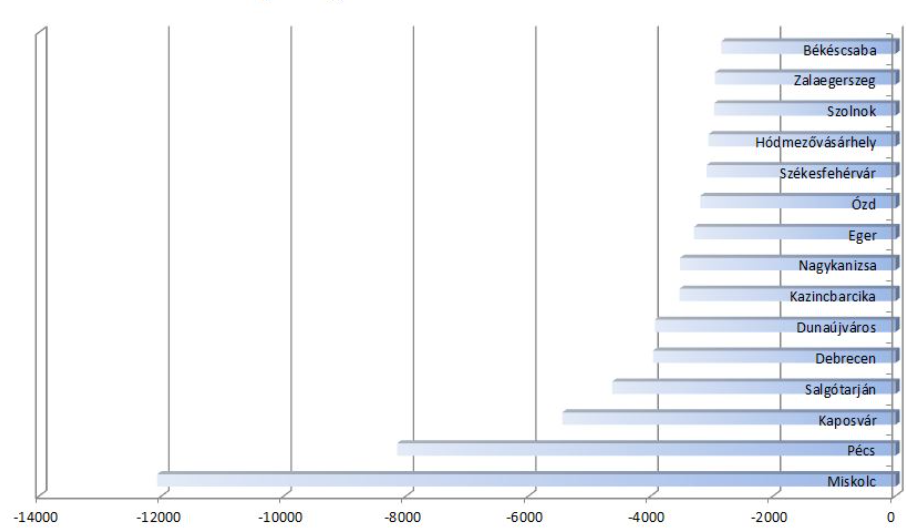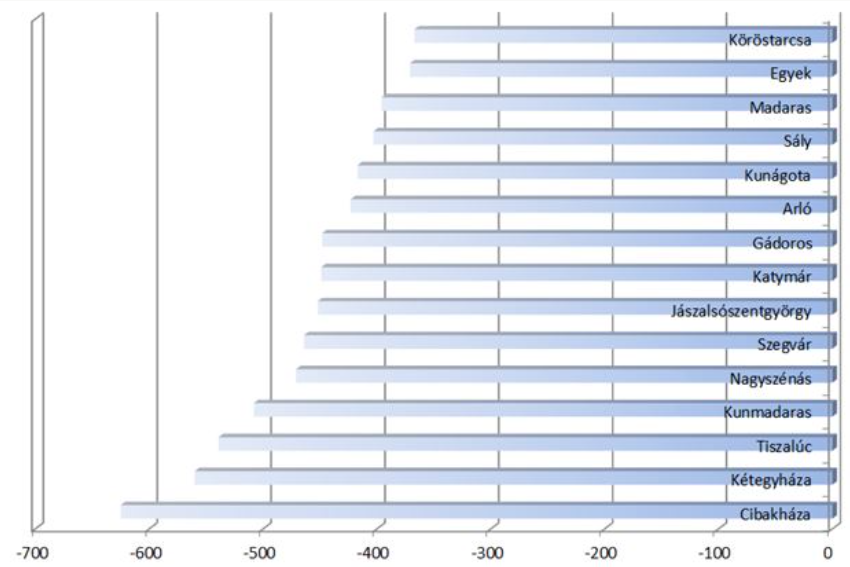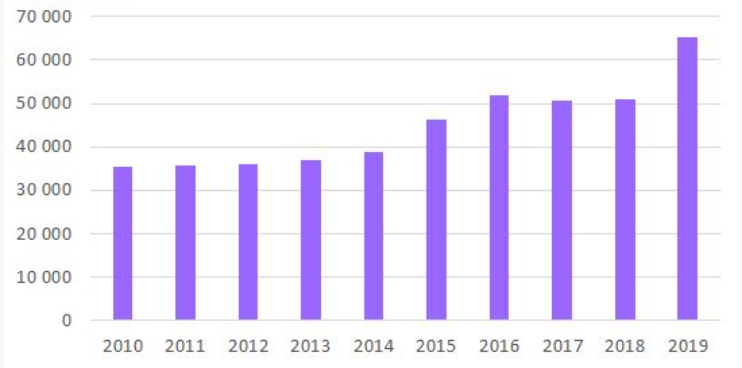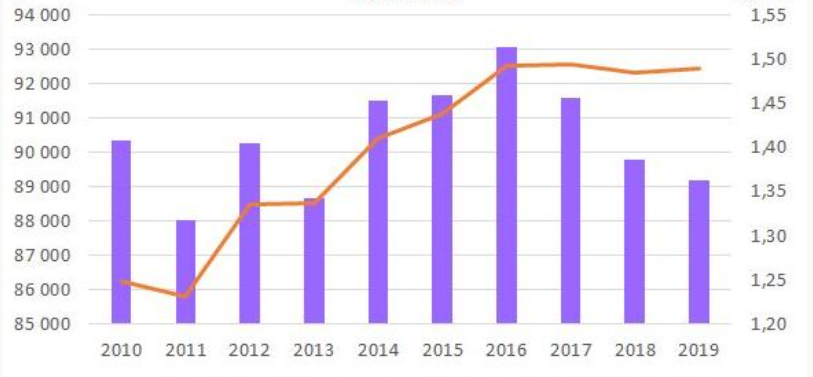Number of marriages in Hungary doubles in first quarter
EnglishLast year the number of marriages skyrocketed, partly due to the Housing Subsidy Scheme for Families (CSOK) and the ‘Baby-expecting Loan’. The 65,268 marriages in 2019 had been unprecedented since 1991. This trend is also having a positive effect on birth rates, which is a much needed outcome, as the population of Hungary has been declining year by year. It is particularly unfavourable that between 2011 and 2019 the population of villages decreased by almost 65,000. We asked the Central Statistical Office (KSH) about current demographic and migration trends.
Between 2011 and 2019 the population of Hungary shrank by more than 162,000. With the exception of the capital, Pest and Győr-Moson-Sopron, the population decreased in all counties, növekedés.hu learned from the Central Statistical Office.
Cities
As for cities, the population decrease was the biggest in Miskolc, Pécs and Kaposvár in the last decade. The diagram below illustrates in which cities the population decreased the most between 2011 and 2019.
Population change 2011-2019

Source Central Statistical Office
Villages
The population of villages in Hungary fell by almost 65,000 between 2011 and 2019. Cibakháza, Kétegyháza and Tiszalúc are the settlements where the decrease in the population was the biggest.Villages with the largest population decline between 2011 and 2019

Source: Central Statistical Office
Marriages and family protection measures
After a long and steady decrease, the number of marriages reached a low point in 2010 with35.5 thousand marriages. In the following six years the number of marriages increased significantly, by about two-thirds, and in 2016, for the first time in twenty years, it rose to over 50,000, according to KSH data.
In 2019, the number of marriages skyrocketed: altogether 65,268 couples got married in 2019, 28 percent more than the previous year, and it had been the highest number since 1991.
Number of marriages 2010-2019

Source: Central Statistical Office
Last year the number of marriages increased in all counties of Hungary. The largest increase was in Tolna and Komárom-Esztergom counties (more than 40 percent), while Nógrád and Somogy saw the lowest increase (15-20 percent).
Both CSOK and the Baby-expecting Loan are likely to have incentivized people to get married and also have children, as only married couples can take advantage of the benefits.
It was after the introduction of CSOK that the number of marriages began to grow dynamically, and the Baby-expecting Loan resulted in an even more significant increase in marriages in the second half of 2019.
In the first eight months of this year, the total number of marriages increased by a further 3.1 percent, according to KSH data, despite the fact that it fell by about 30 percent in May and nearly 25 percent in June on an annual basis because of the restrictions caused by the coronavirus.
The increase in the first eight months was due to data from January-March, not yet affected by the coronavirus, when, continuing the previous year’s boom, more than twice as many marriages were contracted as one year earlier. This trend was broken by the outbreak of the epidemic.
Births and fertility rate
After a long decline, the number of births dropped to a historic low of 88,000 in 2011. After that a slow rise began, resulting in the birth of 93,063 babies in 2016.
Over the past three years, the rise has stopped and the birth rate has started to fall slightly again.
Number of live births and the total fertility rate 2010-2019

Source: Central Statistical Office
Favourable turnaround
The first eleven months of 2019 still saw a 1,200, or 1.5 percent decrease in the number of babies on an annual basis; in December, however, the birth rate suddenly jumped by 8.2 percent, with nearly 600 more babies born, cutting the birth deficit accumulated during the year by 50 percent in the course of one month.
The significant increase in December came exactly ten months after the announcement of the Baby-expecting Loan in February.
In the first eight months of 2020, the upward trend in the birth rate continued, with an overall increase of 4.7 percent, or more than 2,700 children compared to one year before.
There is still work to be done
The total fertility rate (TFR), which is an indicator of the willingness to have children, also reached a historic low in 2011 with a value of 1.23, which means that in that year mothers gave birth to an average of 1.23 children.
The graph above clearly shows that an upward trend started from this point, reaching its local maximum in 2016 with a value of 1.49.
In the following three years the number of births began to decline although the fertility rate remained unchanged. This is due to the steady decline in the number of women of childbearing age. Fewer potential mothers give birth to fewer babies, even if the desire to have children is unchanged.
In the first eight months of 2020 there was a slight change in this trend, as the increase in the birth rate took place in parallel with the increase in the value of the TFR.
The fertility rate in the first eight months of this year rose to 1.54.
In the first half of 2020 the birth rate increased in all regions of the country, the most in Northern Hungary (11.6 percent) and the Northern Great Plain (9.6 percent), while the smallest increase was in Budapest (0.6 percent) and Central Transdanubia (1.2 percent).
It would be very important for the fertility rate in Hungary to rise to at least about 1.8 children. This value does not ensure the reproduction of society yet, but a lower fertility rate could result in a relatively quick further decline in the current birth rate over the next fifteen years.
In order to ensure the survival of Hungarian society, a fertility rate would have to increase to 2.1.
Migration
In terms of the various regions, the Northern Great Plain and Northern Hungary have the weakest population retention, but out-migration is typical also in Southern Transdanubia and the Southern Great Plain. The largest domestic population loss characterizes Szabolcs-Szatmár-Bereg and Borsod-Abaúj-Zemplén counties.
In contrast, Pest County, with its exceptionally high annual migration surplus of around 16,000 people, is the winner of domestic mobility, but the domestic net migration in Central and Western Transdanubia has also been positive in recent years.
After Pest County, Győr-Moson-Sopron appears to be the second most popular county to live in on the basis of domestic migration.
Although Budapest is one of the main destinations of domestic migration, since 2016, however, the capital’s net migration has been negative. This special situation can be explained by many residents relocating to the commuter belt and the increasing trend of suburbanization.
While between 2015 and 2019 the net domestic migration of cities turned negative, in 2019 smaller towns and villages experienced the largest domestic migration gain in recent years.
According to KSH data, mostly settlements with a population of 2,000–10,000 could benefit from the current tendencies of domestic mobility.
Migration of foreigners
In addition to domestic migration, international migration also has a significant impact on the demographic situation of a given area; it is an essential element of population change. The positive net international migration in Hungary has been moderating the population decline caused by natural population loss every year since 2015.
The main destination of foreigners immigrating to Hungary is Budapest, but Western and Central Transdanubia and the Northern Great Plain regions have also become increasingly important in terms of international migration.
Among the counties, Pest, Győr-Moson-Sopron, Komárom-Esztergom, Szabolcs-Szatmár-Bereg and Hajdú-Bihar saw a positive net migration of over 2,000 people in 2019, according to KSH data.
